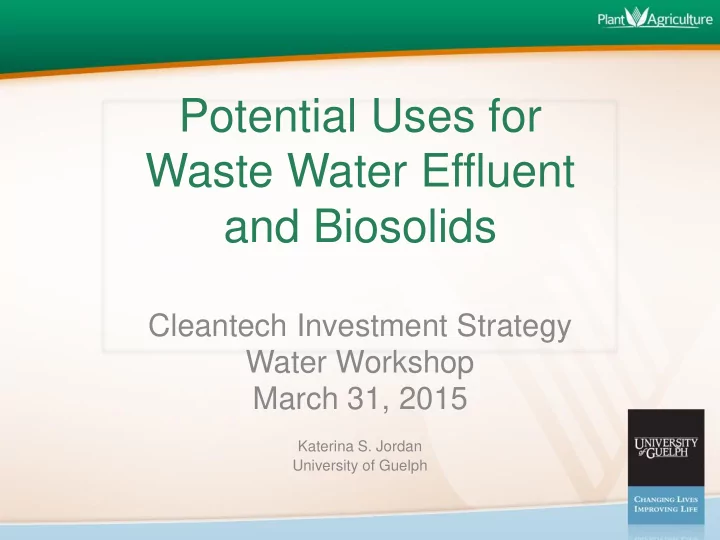

Potential Uses for Waste Water Effluent and Biosolids Cleantech Investment Strategy Water Workshop March 31, 2015 Katerina S. Jordan University of Guelph
Water Use in Canada Source: Environment Canada
Water Use in Ontario Source: Environment Canada
Water use by sector in Ontario Water Use/Sector Water Consumption m3/day Percent Municipal 681,526 37.7 Industrial Manufacturing 511,699 28.3 Agriculture 364,849 20.2 Golf Courses 70,137 3.9 Industrial Mining 61,466 3.4 Industrial Thermal Power 60,466 3.3 Rural Residential 57,240 3.2 Total 1,807,383 100 Adapted from de Loe et al., 2001
Water Use for Sod Production in ON Annual irrigation/water need on sod farms averages 6,084,624 litres per ha As of 2006, 13,034 ha of sod in Ontario 44% of Canada sod production
Use of reclaimed water for sod production Advantages Reduced need for municipal or well water Added benefit of nutrients Reduced dumping of treated wastewater into waterways Natural filtration of pollutants and nutrients through soil and turf system Potential disadvantages Leaching of nutrients or toxins Salt damage to plants
Study at the University of Guelph Objectives : 1. Determine if reclaimed wastewater from various sources could be used to grow Kentucky bluegrass. 2. Determine any potential leaching hazards to the ground water. 3. Observe any changes in soil chemistry resulting from repeated irrigation with reclaimed water 4. Study the changes in soil microbial community through molecular biology techniques.
Methods Examined four different sources of reclaimed water. Municipal tertiary treated Municipal secondary treated Industrial waste water (pig farm) Collected road run-off (golf course) Conducted both greenhouse and field trials
Greenhouse Study Constructed soil columns that acted as lysimeters
Methodology Examined four reclaimed water sources on four Kentucky bluegrass turf varieties/blends Collected leachate every other week Followed turfgrass growth from seeding through establishment (101 days) Collected data on clipping weight, turfgrass quality, - content of leachate NO 3
Reclaimed water properties
Growth of Turf 80 DAS WW Sec Control WW Ter Industrial Run-off
Effect on Turfgrass Quality
Potential Risks to Groundwater
Conclusions None of the reclaimed water sources had sufficient nutrients to support Kentucky bluegrass development Would likely work as irrigation source with supplemental fertilizer. The levels of nitrate leaching through the soil differed depending on the type of reclaimed water used. There was an accumulation of salts in the soil that negatively impacted the development of Kentucky bluegrass.
Use of Reclaimed Wastewater in California (2009)
Primary Turfgrass Sectors and Ontario Turfgrass Acreage Home lawns Municipal and recreational fields Golf courses Sod farms
Primary Turfgrass Sectors and Ontario Turfgrass Acreage Home lawns Municipal and recreational fields Golf courses Sod farms
Potential for use of reclaimed water on turfgrass systems Sod farms Golf courses Most like agricultural Highly irrigated crops Could help with rough No clientele during areas establishment Greens likely too critical Most likely candidate for and delicate wastewater irrigation *Soil type important for both areas*
What about the solids? Municipal Biosolids: Recovered from the sewage treatment process Manufactured in an effort to recycle waste Valuable source of organic matter and nutrients for soil and crops Nitrogen and phosphorus contained have a cash value of $250 per hectare
MBs Types Raw sludge Liquid Dewatered Lyste k
Field Set-up A) Schematic of field lysimeter as described in by Roy et al. (2001), with a soil profile consisting of a 35cm A horizon, (sandy loam), a 25cm B horizon (loamy sand) and a 25 cm C horizon (sand); B) Photo of field site at Guelph Turfgrass Institute in Guelph, ON, Canada prior to soil amendment July 4 2011.
Amendment Application
Soil and leachate collection and storage
Conclusions: Nutrient and Metal Analysis Some of the MB products were sufficient to sustain turfgrass growth Land application of MBs can lead to drainage and surface water contamination based on an increased concentration of nitrate-N and total phosphorus. Management practices that aim to reduce leaching of nutrients would be beneficial Fertilizer rate calculations should focus not only on nitrogen need, but phosphorus need and availability. Metals accumulation and transfer through soil and surface water leachate were negligible or non-existent following land application of MBs, therefore are not considered a risk to ground- or surface waters.
Summary High potential for use of reclaimed wastewater on turfgrass systems Non-edible Sod farms especially have limited exposure to people Soil type and alternate irrigation are important Golf courses can be a sink for reclaimed water as well More research needed Potential for use of municipal water prior to final treatment Energy reduction Turfgrass systems act as natural filters of pollutants and nutrients Solids may be used as alternative source of fertilizer
Acknowledgements: Technical assistance: Graduate students : Alex Porter Patrick Schwieder Dr. Ken Carey Crystal McCall Collaborators: Dr. Kari Dunfield Dr. Eric Lyons
Recommend
More recommend